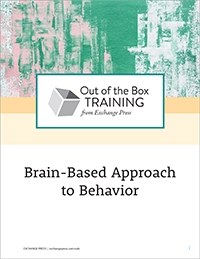Are Your Children in Times Square? Moving from Sensory Overload to Sensory Engagement
What's In This Kit?
This kit is designed to help participants understand the impact of sensory overload in the classroom, especially with the element of light. This training program contains the following components:
- Expected training outcomes and learning objectives
- Training tips and strategies
- Training benchmarks
- Preparation and implementation steps
- Handouts
- PowerPoint presentation (19 MB download)
- The article "Are Your Children in Times Square? Moving from Sensory Overload to Sensory Engagement" by Sandra Duncan and Michelle Salcedo
- References
- Resources
- Training Certificate for Learner �" Certificate of Attendance and Participation
- Training Certificate for Trainer �" Award Certificate
Who's the Target Audience?
The target audiences for this are beginning, intermediate and advanced teachers working with children from birth to age 8. Encouraging teachers to consider the
classroom door from a child’s perspective, this kit helps teachers understand that entryways are an essential aspect of classroom design.
| Teacher Skill Level | ||||||||||||
|
||||||||||||
| Children's Age Level | ||||||||||||
|
Kit Timeline:
Preparation time for this kit is estimated at 1.5 hour. Implementation and actual training time is 4.5 hours, which includes 2.0 of face-to-face training and 2.5 hours of independent study. There is a bonus activity in the Group Instruction face-to-face training, which can add as much as 1 hour to the training time.
Training Outcomes:
- Describe the difference between lighting and illumination.
- Conduct a lighting assessment of their classroom.
- Plan, implement, and document (i.e., photos, videos, sketches, artifacts) at least one learning experience that allows children to immerse themselves in manipulating light to promote children’s sensory engagement in the classroom.
- Enhance classroom mood by adding illumination in at least one classroom area or learning center.
These training outcomes address the following professional standards:
- National Association for the Education of Young Children’s (NAEYC) Standards and Accreditation Performance Criteria (2005). More information on NAEYC’s learning standards can be found at
www.naeyc.org.
The teaching staff arranges the environment to be welcoming and accessible. (9.A.09)
The teaching staff reorganizes the environment when necessary to help children explore new concepts and topics, sustain their activities, and extend their learning. (3.E.01)
- National Accreditation Commission for Early Care and Education Programs, National Association of Child Care Professionals (NACCP) (2005). More information on NACCP’s learning standards can be found at www.naccp.org.
Children’s creativity is promoted through daily opportunities for self-expression, symbolic representation, and development of aesthetic sensibility. (D16)
The arrangement of the classroom encourages children to become engaged and promotes child-centered learning experiences. (D8)
- Head Start Child Outcomes Framework (2000). Head Start Child Outcomes Framework identifies domain elements and indicators that describe long-term learning goals. More information on Head Start’s
Child Outcomes Framework can be found at
http://eclkc.ohs.acf.hhs.gov/hslc/tta-system/teaching/eecd/Assessment/Child%20Outcomes/
The child demonstrates growing confidence in a range of abilities and expresses pride in accomplishments. (Domain: Social & Emotional Development �" Self-Concept)
- The Head Start Child Development and Early Learning Framework (2010). The Head Start Child Development and Early Learning Framework provide Head Start and other early childhood programs with a description of the developmental building blocks that are most important for a child’s school and long-term success. More information on the Head Start Child Development and Early Learning Framework can be found at:
http://eclkc.ohs.acf.hhs.gov/hslc/tta-system/teaching/eecd/Assessment/Child%20Outcomes/
HS_Revised_Child_Outcomes_Framework(rev-Sept2011).pdf and at http://eclkc.ohs.
acf.hhs.gov/hslc/tta-system/teaching/eecd/Assessment/Child%20Outcomes/revised-
child-outcomes.html.
The child creates artistic works that reflect thoughts, feelings, experiences, or knowledge. (Domain: Creative Arts Expression �" Art)
- Universal Design for Learning (UDL). First defined by the Center for Applied Special Technology (CAST) in the 1990s, the UDL framework recognizes that the way individuals learn can be unique. More information about UDL in the early childhood classroom can be found at
http://www.ttacnews.vcu.edu/2011/01/udl-101-in-the-early-childhood-environment.html.
UDL believes that the curriculum should be created to provide the following:
The curriculum provides multiple means of representation to give Learners various ways of acquiring information and knowledge.
The curriculum provides multiple means of expression to provide Learners alternatives for demonstrating what they know.
The curriculum provides multiple means of engagement to tap into Learners’ interests, challenge them appropriately, and motivate them to learn.
It is important to locate additional state and local standards that relate to this topic or requirements of other regulatory bodies specific to your program.
Note: Downloadable PDFs are only available for download in pdf format. Directions for downloading follow immediately after purchase.
